Cambridge Scottie Decorated Glassware
Article by Janet Felmeth
Photos by Mary Lamica
Issue No. 442 - October 2010
Webmaster's NOTE: Originally prepared as a report of the May 2010 program meeting of the Pittsburgh Lowell Innes Chapter of the National American Glass Club and reprinted with their permission.
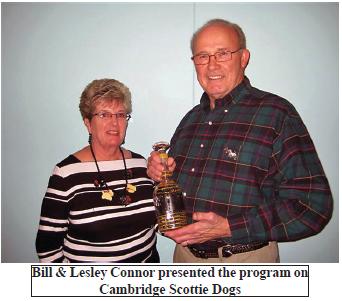 Bill and Lesley Connor have collected Scotties since
the 1976 Centennial year when they acquired a real live
Scottish terrier named Yankee Doodle Dandy, called
Dandy, and since then have always had one to three of
the dogs in their home. Soon after they began collecting
everything Scottie in multiple forms, mediums and genres
both old and new. Their collection is primarily glass, but
also includes pottery, ceramics, porcelain, wood, metal,
textiles, books, art work, jewelry and clothing.
Bill and Lesley Connor have collected Scotties since
the 1976 Centennial year when they acquired a real live
Scottish terrier named Yankee Doodle Dandy, called
Dandy, and since then have always had one to three of
the dogs in their home. Soon after they began collecting
everything Scottie in multiple forms, mediums and genres
both old and new. Their collection is primarily glass, but
also includes pottery, ceramics, porcelain, wood, metal,
textiles, books, art work, jewelry and clothing.
They have Scotties made of foreign glass manufactured by 17 different companies. Pieces by domestic producers in addition to Cambridge are: Heisey, Fry, Westmoreland, McKee, Jeanette, Akro Agate, Diamond, Kanawha, Imperial, Fenton, Boyd, L. E. Smith, L. J. House, Hazel Atlas, Corning, Anchor-Hocking, Bartlett-Collins, Libbey, Federal, Mosser, Viking, St. Clair and Pilgrim. (In case you weren’t counting, that's 24 total.) So when Cheryl Kevish met the Connors during a Preservation Fair at the Carnegie and asked them to share their collection, they decided to limit the presentation to Cambridge. A good decision as their Cambridge glass filled two long tables!
Up until the late 1980's the Connors purchased only new
items. Then they joined a Scottie collectors group and saw
pictures of Cambridge glass decorated with Scotties which
was made in the 1920's and 30's. That started their quest
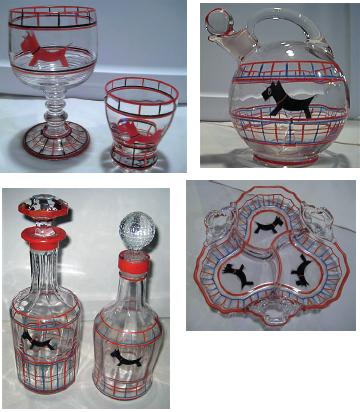 for Scottie decorated Cambridge glass at antique malls, but
they never found any. In the 90's they joined a National
Cambridge Collectors (NCC) study group, The Elegant
Glass Collectors Club, with members in southeast PA and
NJ. At this time they discovered eBay where most of the
items they displayed for us were found.
for Scottie decorated Cambridge glass at antique malls, but
they never found any. In the 90's they joined a National
Cambridge Collectors (NCC) study group, The Elegant
Glass Collectors Club, with members in southeast PA and
NJ. At this time they discovered eBay where most of the
items they displayed for us were found.
Because so many companies used the Scottie design, it
is sometimes difficult to identify the maker. However,
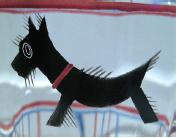 two designs are unique and exclusive to Cambridge --
the Swayback Scottie (at left) and the Three Canny Scots. The
company also made figural Scottie bookends some of
which are solid and others are more hollow. It is assumed
that the solid bookends were made earlier and the switch
made to the hollow form to reduce costs. These are the
main, but not the only, styles we were fortunate to see.
two designs are unique and exclusive to Cambridge --
the Swayback Scottie (at left) and the Three Canny Scots. The
company also made figural Scottie bookends some of
which are solid and others are more hollow. It is assumed
that the solid bookends were made earlier and the switch
made to the hollow form to reduce costs. These are the
main, but not the only, styles we were fortunate to see.
The Swayback Scottie, a collector's term not used by Cambridge Glass Co., is usually found on clear glass and depicted in profile with a collar, ring around the eye and hair sticking out on the head, legs, back and tail. Scottie appears in black enamel paint with further red and blue enameling decorating the rest of the piece. Examples shown by Bill were three decanters, a three compartment relish, an ice bucket and an Old Fashioned tumbler.
Much less common
are the red Swayback Scottie
with red and black enameling as shown on a tumbler and
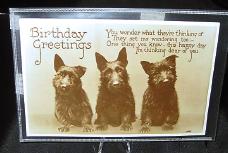
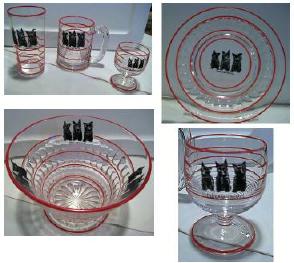 10-ounce Talley Ho goblet. Interestingly these are listed
in the old catalogs as "Sports Novelties" because barware
was inappropriate during Prohibition which ran 1917 to
1933.
10-ounce Talley Ho goblet. Interestingly these are listed
in the old catalogs as "Sports Novelties" because barware
was inappropriate during Prohibition which ran 1917 to
1933.
The Three Canny Scots are forlorn looking Scotties sitting in a row with the words "Three Canny Scots" beneath them. The decal image was almost certainly based on an English picture postcard (shown at left) postmarked in 1930, which Bill showed to us, of three real Scotties. This decoration is only known to exist in black with the accompanying enameling most commonly in red.
The examples were a Martha Washington plate, Martha Washington bowl, a decanter, Tally Ho handled stein, tall tumbler and a Tally Ho low stem oyster cocktail. Other much less common enamel colors are blue, yellow and green. Examples with yellow enameling included a relish, a canapé set and a large 28-ounce decanter. The only example with green enameling the Connors are aware of is their bitters bottle. (Photos at right)
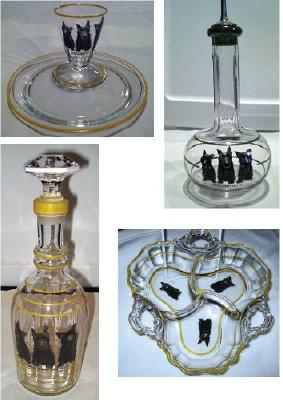
Both the Swayback Scottie and the Three Canny Scots appear in silver on Cambridge ebony glassware starting in 1931. The decoration was done by a transfer process at the Cambridge factory.
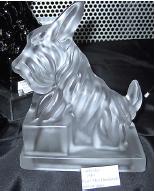 In 1940 Cambridge began producing a line of figural glass
animals that included Scottie bookends made in crystal
(most common), ebony (black
glass) and pearl mist (frosted
crystal - shown at left) that was given an
additional post-etching polishing
step that resulted in a soft, semitranslucent
yet velvety smooth
to the touch surface. These are
not marked and few paper labels
remain.
In 1940 Cambridge began producing a line of figural glass
animals that included Scottie bookends made in crystal
(most common), ebony (black
glass) and pearl mist (frosted
crystal - shown at left) that was given an
additional post-etching polishing
step that resulted in a soft, semitranslucent
yet velvety smooth
to the touch surface. These are
not marked and few paper labels
remain.
A milk glass bookend was shown in the 1949-53 catalogue, but it is thought that it was never produced commercially. Bill and Lesley have talked with a NCC member whose relative worked at the Cambridge factory and who believes it was a prototype that was eventually used in her home as a doorstop. She recalled as a young girl moving it out of the way with her foot.
Some end-of-day specials thrown together by factory workers have been seen in the now closed Bennett Museum in Cambridge which had Scotties with a crystal body and a cobalt head and another with an ebony body and crystal head.
When Cambridge closed their doors for the final time in
1958, Imperial bought many, if not all, of the Cambridge
moulds including the Scottie bookend. Twenty-one years
later, in 1979, the NCC commissioned Imperial to make a
commemorative from the original mould to be used as a
fundraiser. To assure there was no chance of confusing the
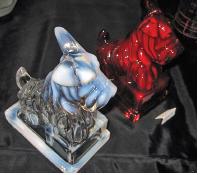 commemorative with the original Cambridge, they insisted
that the glass was amethyst rather than black and that each
piece be prominently and permanently marked with the
letters NCC and 1979 as well as the Imperial mark, for
that time, the superimposed letters LIG (Lenox Imperial
Glass). The mark was placed on the base at the side with
the dog facing left. Records show that on May 1, 1979
there were 150 pairs of these bookends made to fulfill the
contract.
commemorative with the original Cambridge, they insisted
that the glass was amethyst rather than black and that each
piece be prominently and permanently marked with the
letters NCC and 1979 as well as the Imperial mark, for
that time, the superimposed letters LIG (Lenox Imperial
Glass). The mark was placed on the base at the side with
the dog facing left. Records show that on May 1, 1979
there were 150 pairs of these bookends made to fulfill the
contract.
Two complications have resulted in variations of this piece occasionally surfacing. First, before finalizing the design, six test pieces were reportedly made with the mark below the dog's feet which was rejected by NCC as not sufficiently prominent. Second, before NCC could market their commemoratives, a batch of bookends identical to the clubs, except not frosted, was confiscated at a flea market by an NCC past president. They were reportedly smashed, however these and the test pieces do show up occasionally.
Imperial used the Cambridge bookend mould in 1982 as part of their carmel slag series of figural pieces. These are marked with the Imperial mark of the time period superimposed ALIG (Arthur Lorch Imperial Glass). In 1985 when Imperial closed their doors, NCC bought many of the original Cambridge moulds including the Scottie bookend.
In June of 1998, a flash
flood destroyed the
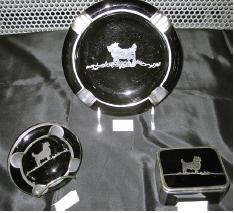 Museum of Cambridge
Glass and once again
the Scottie came to
the rescue as a fund
raiser. In 1999 the
NCC offered what
turned out to be a series
of five reproduction
Scottie bookends made by Mosser Glass. The colors
are moonlight blue (light transparent blue), carmen
(red), cobalt (deep blue), forest green and crystal
opalescent. The first three colors are marked NCC, year of
manufacture, and has the Mosser mark which is a capital
M surrounded by the outline of the shape of the state of
Ohio. The mark on the fourth and fifth offerings consists
of only the letters NCC.
Museum of Cambridge
Glass and once again
the Scottie came to
the rescue as a fund
raiser. In 1999 the
NCC offered what
turned out to be a series
of five reproduction
Scottie bookends made by Mosser Glass. The colors
are moonlight blue (light transparent blue), carmen
(red), cobalt (deep blue), forest green and crystal
opalescent. The first three colors are marked NCC, year of
manufacture, and has the Mosser mark which is a capital
M surrounded by the outline of the shape of the state of
Ohio. The mark on the fourth and fifth offerings consists
of only the letters NCC.
Even today the Scottie lives on in a well-marked smaller form. Boyd Glass took the bookend to Island Mold and had them make a half-size replica which is indeed half as tall, but has only 1/8th the volume and thus appears much smaller. Starting in 1983 until the present time they have made at least one color a year from the "retired" Boyd mould. And so in 2010 there are 77 colors out there for collectors to seek.
Bill concluded by showing and narrating a video he shot of Mosser making the commemorative Scottie bookends. Many thanks to Bill and Lesley for sharing their Scottie glass with us and detailing how we can identify the original Cambridge pieces.
